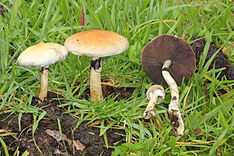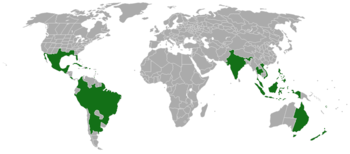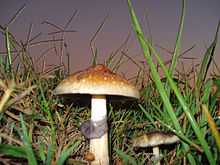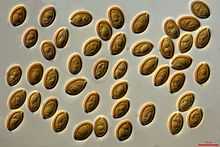Psilocybe cubensis
| Psilocybe cubensis | |
|---|---|
 | |
| Scientific classification | |
| Kingdom: | Fungi |
| Division: | Basidiomycota |
| Class: | Agaricomycetes |
| Order: | Agaricales |
| Family: | Hymenogastraceae |
| Genus: | Psilocybe |
| Species: | P. cubensis |
| Binomial name | |
| Psilocybe cubensis (Earle) Singer | |
 | |
| Approximate Range of Psilocybe cubensis | |
| Psilocybe cubensis | |
|---|---|
|
| |
| gills on hymenium | |
|
cap is convex or flat | |
|
hymenium is adnate or adnexed | |
| stipe has a ring | |
| spore print is purple | |
| ecology is saprotrophic | |
| edibility: psychoactive | |
Psilocybe cubensis is a species of psychedelic mushroom whose principal active compounds are psilocybin and psilocin. Commonly called boomers, magic mushrooms, golden tops, cubes, shrooms or gold caps, it belongs to the Hymenogastraceae family of fungi and was previously known as Stropharia cubensis. It is the most well known psilocybin mushroom due to its wide distribution and ease of cultivation.
Taxonomy and naming
The species was first described in 1906 as Stropharia cubensis by Franklin Sumner Earle in Cuba.[1] In 1907 it was identified as Naematoloma caerulescens in Tonkin by Narcisse Théophile Patouillard,[2] while in 1941 it was called Stropharia cyanescens by William Alphonso Murrill in Florida.[3] These synonyms were later assigned to the species Psilocybe cubensis.[4][5]
The name Psilocybe is derived from the Greek roots psilos (ψιλος) and kubê (κυβη),[6] and translates as "bald head". Cubensis means "coming from Cuba", and refers to the type locality published by Earle.
Description

- Pileus: 2–8 cm, Conic to convex, becoming broadly convex to plane in age, may retain a slight umbo, margin even, reddish-cinnamon brown when young becoming golden brown in age, viscid when moist, hygrophanous, glabrous, sometimes with white universal veil remnants decorating the cap, more or less smooth. Flesh whitish, bruising blue in age or where injured.
- Gills: Adnate to adnexed to sometimes seceding attachment, close, narrow to slightly wider towards the center, at first pallid to gray, becoming dark purplish to blackish in age, somewhat mottled, edges remaining whitish.
- Spore Print: Blueish violet
- Stipe: 4–15 cm long, .5–1.5 cm thick, white to yellowish in age, hollow or somewhat stuffed, the well developed veil leaves a persistent white membranous annulus whose surface usually becomes concolorous with the gills because of falling spores, bruising blue or bluish-green when injured.
- Taste: Farinaceous
- Odor: Farinaceous
- Microscopic features: Spores 11.5–17 x 8–11 µm, subellipsoid, basidia 4-spored but sometimes 2- or 3-, pleurocystidia and cheilocystidia present.[7]

Entheogenic use

Psilocybe cubensis is probably the most widely known of the psilocybin containing mushrooms used. Its major psychoactive compounds are:
- Psilocybin (4-phosphoryloxy-N,N-dimethyltryptamine)
- Psilocin (4-hydroxy-N,N-dimethyltryptamine)
- Baeocystin (4-phosphoryloxy-N-methyltryptamine)
- Norbaeocystin (4-phosphoryloxytryptamine)
The concentrations of psilocin and psilocybin, determined by high-performance liquid chromatography, were determined to be in the range of 0.14–0.42%/0.37–1.30% (dry weight) in the whole mushroom, 0.17–0.78%/0.44–1.35% in the cap and 0.09–0.30%/0.05–1.27% in the stem.[8]
Individual brain chemistry and psychological predisposition play a significant role in determining appropriate doses. For a modest psychedelic effect, a minimum of one gram of dried Psilocybe cubensis mushrooms is ingested orally. 0.25–1 gram is usually sufficient to produce a mild effect, 1–2.5 grams usually provides a moderate effect. 2.5 grams and higher usually produces strong effects.[9] For most people, 3.5 dried grams (1/8 oz) would be considered a high dose and may produce an intense experience; this is, however, typically considered a standard dose. For many individuals doses above 3 grams may be overwhelming. For a few rare people, doses as small as 0.25 grams can produce full-blown effects normally associated with very high doses. For most people, however, that dose level would result in virtually no effects. Due to factors such as age and storage method, the psilocybin content of a given sample of mushrooms will vary. Effects usually start after approximately 20–60 minutes (depending on method of ingestion and stomach contents) and may last from four to ten hours, depending on dosage. Visual distortions often occur, including walls that seem to breathe, a vivid enhancement of colors and the animation of organic shapes. At higher doses, experiences tend to be less social and more entheogenic, often intense and spiritual in nature.[citation needed]
The effects of very high doses can be overwhelming depending on the particular strain, growth method, and the individual. Psilocybe cubensis mushrooms can come in rather different sizes. It is recommended that one weigh the actual mushrooms, as opposed to simply counting them. People taking MAOIs need to be careful, as psilocybin and psilocin are metabolized by the enzyme monoamine oxidase. A monoamine oxidase inhibitor reduces the body's ability to metabolize psilocin and psilocybin, greatly increasing the intensity of the experience. This can sometimes produce uncomfortable or undesirably intense experiences.[citation needed]
Legality
In much of the world, possession of mushrooms containing psilocybin is illegal.
Cultivation
Personal-scale cultivation of Psilocybe cubensis mushrooms ranges from the relatively simple and small-scale PF Tek and other "cake" methods, that produce a limited amount of mushrooms, to advanced techniques utilizing methods of professional mushroom cultivators. These advanced methods require a greater investment of time, money, and knowledge, but reward the diligent cultivator with far larger and much more consistent harvests.
Terence McKenna and his brother Dennis made "Psilocybe cubensis" particularly famous when they published Psilocybin: The Magic Mushroom Grower's Guide in the 1970s upon their return from the Amazon rainforest, having deduced new methods (based on pre-existing techniques) for growing psilocybin mushrooms and assuring their audience that "Psilocybe cubensis" were amongst the easiest psilocybin-containing mushrooms to cultivate.[10]
See also
- List of psilocybin mushrooms
- Psilocybin mushrooms
- Manna
- Botanical identity of soma-haoma
Notes
- ↑ Earle FS. "Algunos hongos cubanos". Información Anual Estación Central Agronomica Cuba (in Spanish) 1: 225–42.
- ↑ Patouillard NT (1907). "Champignons nouveaux du Tonkin". Bulletin de la Société Mycologique de France (in French) 23 (1).
- ↑ Murrill, W.A. (May–June 1941). "Some Florida Novelties". Mycologia 33 (3): 279–287. JSTOR 3754763.

- ↑ "Naematoloma caerulescens Pat. 1907". MycoBank. International Mycological Association. Retrieved 2010-10-18.
- ↑ "Stropharia cyanescens Murrill 1941". MycoBank. International Mycological Association. Retrieved 2010-10-18.
- ↑ Cornelis, Schrevel (1826). Schrevelius' Greek lexicon, tr. into Engl. with numerous corrections. p. 358. Retrieved 2011-10-04.
- ↑ Stamets, Paul (1996). Psilocybin Mushrooms of the World. Ten Speed Press. pp. g. 108. ISBN 0-89815-839-7.
- ↑ Tsujikawa, K.; Kanamori, T.; Iwata, Y.; Ohmae, Y.; Sugita, R.; Inoue, H.; Kishi, T. (December 2003). "Morphological and chemical analysis of magic mushrooms in Japan". Forensic Science International 138 (1–3): 85–90. doi:10.1016/j.forsciint.2003.08.009. PMID 14642723.

- ↑ Erowid (2006). "Erowid Psilocybin Mushroom Vault: Dosage" (shtml). Erowid. Retrieved 2006-11-26.
- ↑ http://www.levity.com/eschaton/tmUSed.html
Further reading
- Guzman, G. The Genus Psilocybe: A Systematic Revision of the Known Species Including the History, Distribution and Chemistry of the Hallucinogenic Species. Beihefte zur Nova Hedwigia Heft 74. J. Cramer, Vaduz, Germany (1983) [now out of print].
- Guzman, G. "Supplement to the genus Psilocybe." Bibliotheca Mycologica 159: 91-141 (1995).
- Nicholas, L.G.; Ogame, Kerry (2006). Psilocybin Mushroom Handbook: Easy Indoor and Outdoor Cultivation. Quick American Archives. ISBN 0-932551-71-8.
- Oss, O.T.; O.N. Oeric (1976). Psilocybin: Magic Mushroom Grower's Guide. Quick American Publishing Company. ISBN 0-932551-06-8.
- Stamets, Paul; Chilton, J.S. (1983). Mushroom Cultivator, The. Olympia: Agarikon Press. ISBN 0-9610798-0-0.
- Stamets, Paul (1996). Psilocybin Mushrooms of the World. Berkeley: Ten Speed Press. ISBN 0-9610798-0-0.
External links
| Wikimedia Commons has media related to Psilocybe cubensis. |
- Psilocybe cubensis in Index Fungorum.
- The Ones That Stain Blue Studies in ethnomycology including the contributions of Maria Sabina, Dr. Albert Hofmann and Dr. Gaston Guzman.
- Erowid Psilocybin Mushroom Vault
| ||||||||||||||||||||